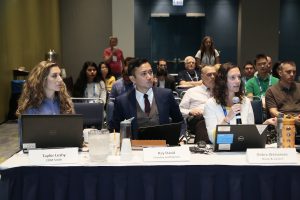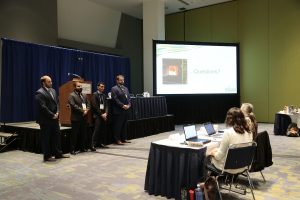Student teams from the University of British Columbia (UBC; Vancouver, Canada) and the University of Colorado (UC; Boulder) left WEFTEC 2019 as winners of the 18th-annual Water Environment Federation (WEF; Alexandria, Va.) Student Design Competition.

Judge Debra Weissman of Black & Veatch (Overland Park, Kan.) offers feedback to a team of Wastewater-category student innovators during the 18th annual Water Environment Federation (Alexandria, Va.) Student Design Competition. Teams from the University of British Columbia (Vancouver) and the University of Colorado (Boulder) won this year’s top prizes. Photo courtesy of Oscar & Associates.
The competition, which showcased innovative design projects from 30 universities, recognizes outstanding solutions to local water quality issues in two categories: Water Environment and Wastewater. Successful teams evaluated various potential solutions to their issue of choice, performed thorough calculations and performance assessments, and recommended the most cost-effective interventions.
This year’s Student Design Competition sponsors included GDH Consulting (Tulsa, Okla.), Greeley and Hansen (Chicago), Black & Veatch (Overland Park, Kan.), and CDM Smith (Boston, Mass.). Representatives from sponsor organizations served as contest judges, joined by additional experts from the Metropolitan Water Reclamation District of Greater Chicago.
“The judges were thrilled about their choice of winners,” said Megan Livak, manager of WEF’s Students & Young Professionals Committee. “The success of the day definitely reflected the effort of the young professionals who spent a year organizing the event.”
Real-World Design Experience
Water Environment category judges lauded the UBC team for their project, which evaluated two potential solutions to improve management of runoff from aircraft de-icing fluid at nearby Vancouver International Airport. The airport does not currently have on-site treatment capabilities for de-icing fluid runoff, which contains the pollutant glycol, and spends an estimated $1 million each year disposing of used fluid.
The UBC team determined whether it would be more economical for the airport to construct wetlands that would accept and naturally treat the de-icing fluid runoff, or instead implement a glycol recovery system.
Calculating both up-front expenses and life-cycle operations and maintenance costs, the team determined that the constructed-wetlands approach would save the airport around $19 million over 30 years compared to the glycol recovery system while enhancing protections for nearby waterways.
The UBC team included Luthfi Subabio, James Craxton, Daniel Luo, Johnson Li, and faculty adviser Noboru Yonemitsu.

Students from George Mason University (Fairfax, Va.) described potential upgrades to solids-handling infrastructure at the H.L. Mooney Advanced Water Reclamation Facility in Woodbridge, Va. Photo courtesy of Oscar & Associates.
Other 2019 winners in the Water Environment category included Georgia Institute of Technology (Atlanta) in second place; Northeastern University (Boston, Mass.) in third place; and the University of Central Florida (Orlando) in fourth place.
In the Wastewater category, the UC team worked with the City of Gunnison (Colo.) Department of Public Works to plan water resource recovery facility (WRRF) renovations that will enable the utility to comply with future regulations. The WRRF requested solutions for the area’s chronic problems with inflow and infiltration, which result in diluted wastewater influent that prevents the utility from implementing enhanced nutrient removal technologies.
The UC team, which includes Powell Hinson, Rachel Knobbs, Lin Ye, Brandon DaSilva, Ryan Smith, and faculty adviser Angela Bielefeldt, developed a 50-year renovation plan that enables the utility to implement enhanced nutrient removal while also addressing infiltration and inflow and minimizing energy costs. The team’s winning design involves submerging existing mechanical aerators in oxidation ditches, creating a new anaerobic zone, installing dissolved oxygen probes, and adding variable frequency blowers to enable simultaneous nitrification/denitrification.
Also recognized in the Wastewater category were North Carolina State University (Raleigh) in second place; Utah State University (Logan) in third place; and the Milwaukee (Wis.) School of Engineering in fourth place.
Stiff Competition
2019 Student Design Competition contestants hailed from all corners of the U.S. and Canada, representing 26 WEF Member Associations. WEF’s Students & Young Professionals Committee also welcomed a team from Singapore, who presented a bioretention system intended to treat runoff from commercial plant nurseries.
Student innovators from the following institutions presented their projects during the competition:
- George Mason University (Fairfax, Va.)
- Georgia Institute of Technology (Atlanta)
- Iowa State University (Ames)
- Johns Hopkins University (Baltimore, Md.)
- Louisiana State University (Baton Rouge)
- Manhattan College (Riverdale, N.Y.)
- Milwaukee (Wis.) School of Engineering
- National University of Singapore
- North Carolina State University (Raleigh)
- North Dakota State University (Fargo)
- Northeastern University (Boston, Mass.)
- Northern Arizona University (Flagstaff)
- Old Dominion University (Norfolk, Va.)
- San Diego (Calif.) State University
- SUNY College of Environmental Science and Forestry (Syracuse, N.Y.)
- Texas Tech University (Lubbock)
- University of British Columbia (Vancouver)
- University of Central Florida (Orlando)
- University of Colorado (Boulder)
- University of Guelph (Ontario, Canada)
- University of Idaho (Moscow)
- University of Illinois at Urbana-Champaign
- University of Nebraska-Lincoln at Omaha
- University of Nevada, Las Vegas
- University of Notre Dame (Ind.)
- University of South Florida (Tampa)
- University of Tennessee Knoxville
- Utah State University (Logan)
- Youngstown (Ohio) State University
Interested in participating in next year’s Student Design Competition? Stay up to date with the Students & Young Professionals Committee on the WEF website for information about the 2020 application period, and read the committee’s guide to forming a Student Design Competition team to begin your preparations.
— Justin Jacques, WEF Highlights








November 6, 2019
Featured